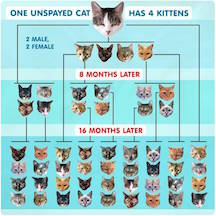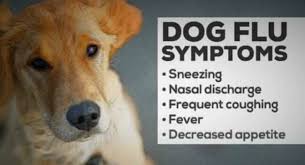Teaching Kids About Spay & Neuter (Speuter)
Lynn Jackson, REASON
 Lynn Jackson is at the forefront of educating students in Burke County, North Carolina about the acute feral cat and sterilization problems faced by this part of the U.S. She visits with fourth graders and teaches responsible pet ownership.
Lynn Jackson is at the forefront of educating students in Burke County, North Carolina about the acute feral cat and sterilization problems faced by this part of the U.S. She visits with fourth graders and teaches responsible pet ownership.
Lynn Jackson, secretary for REASON (Reduce Euthanasia and Spy or Neuter) explains that they have a big feral cat and roaming dog problem in Burke County, North Carolina. These animals are not spayed or neutered and have no identification on them. Lynn explains that it is a huge problem, especially in the mountains and that it's more of a cultural issue there and lack of education.
The goal of REASON is educate people on the importance of spaying and neutering their pets. Their program, called PREP (Pet Responsibility Education Program), targets 4th grade students in the elementary public schools.
Lynn explains that they are always working on trying to educate the adults, but unfortunately most adults already have formed opinions and don't change their ways. So after Lynn bumped her head a few times, she decided to circumvent that to reach the kids in their formidable years.
They decided to work with fourth grade students, who are around 9 to 10 years of age. At this age, they're very receptive to learning and carrying out the things that they learn. Lynn doesn't want to have kids any younger than this go through the program, because they talk about things like euthanasia, which can be a little too harsh for the younger ones. It's too hard to explain to them that over 3,000 animals are killed every year. Even with the fourth graders, she has to dance around that a little bit, depending on what the classroom looks like.
It was a little bit of work, but she was able to get this program into the public school system and it has been a huge success.
 The program consists of basically six 45-minute lessons on how these children can be a responsible pet owner. It's also how they can help stop the over population of pets in their county. Burke County put down over 3,500 animals last year. They teach the children how they can make sure that their pet is healthy and taken care of. They also teach them how they can be safe around dogs and cats when they come across them roaming around and who to call in these situations. In addition, they teach them how they can make a responsible decision about providing for a pet its entire life. The program then teaches them how they can be advocates for animals and speak up for them.
The program consists of basically six 45-minute lessons on how these children can be a responsible pet owner. It's also how they can help stop the over population of pets in their county. Burke County put down over 3,500 animals last year. They teach the children how they can make sure that their pet is healthy and taken care of. They also teach them how they can be safe around dogs and cats when they come across them roaming around and who to call in these situations. In addition, they teach them how they can make a responsible decision about providing for a pet its entire life. The program then teaches them how they can be advocates for animals and speak up for them.
One main part of the class is having the students write a "Speuter" story as part of a friendly competition. Speuter is a word made up of the two words spay and neuter. The kids like this and have fun with it. They also like the word multipli-'cat'-tion, because female cats can multiply like crazy when they are not spayed. Lynn also asks students to explain why spaying and neutering is important in their story.
Lynn explains that the kids aren't really vocal at first. However, by the end they're hugging her and they're in love with her and she's in love with them. It breaks her heart when she has to leave. But there are a few that speak out and say that their daddy won't let them do that, or it's just a dog. However, you do get the kids that go home and come back saying that they told their mom and dad, or grandma and grandpa, and they're going to go out and buy a leash and they're going to go get their dog chipped or even spayed or neutered.
So it kind of works in both ways, according to Lynn, and if she reaches one kid and saves one dog or one cat, it's all worth it to her.
Visit Website
Don't Litter - Spay or Neuter Instead! - Dr. Debbie
 World Spay Day is February 28, 2023. Do you believe your beautiful pedigreed pooch just has to be bred, or that your cat can't possible get outside to become pregnant, or that you long to have just one litter from Fluffy? If so, listen in to the unified pet health message of Spay Day. Shelter staff, veterinarians, and animal advocates all join together to encourage spaying and neutering. It's the right thing to do for your pet's health, and is a step forward in addressing pet overpopulation issues. With approximately 1.5 million dogs and cats euthanized at U.S. shelters every year, pet owners can do their part to avoid unintended and unnecessary breeding.
World Spay Day is February 28, 2023. Do you believe your beautiful pedigreed pooch just has to be bred, or that your cat can't possible get outside to become pregnant, or that you long to have just one litter from Fluffy? If so, listen in to the unified pet health message of Spay Day. Shelter staff, veterinarians, and animal advocates all join together to encourage spaying and neutering. It's the right thing to do for your pet's health, and is a step forward in addressing pet overpopulation issues. With approximately 1.5 million dogs and cats euthanized at U.S. shelters every year, pet owners can do their part to avoid unintended and unnecessary breeding.
Your individual decisions on altering your pet do matter. Animals, left to do what they will, result in a lot of generations of whiskers and tails in just a short period of time. A pair of dogs can produce 67,000 puppies in 3 years' time. And cats in that same time frame can prosper to over 420,000 kittens.
Common Spay & Neuter Fallacies:
Isn't it better to let my female dog go into heat before I spay her?
FALSE. You can minimize the risk of breast cancer to zero by spaying before the first heat. Allow her to have a few heat cycles, and your dog has a 25% chance of developing breast cancer. The health benefits for females also include preventing uterine cancer and the life-threatening reproductive infection, pyometra.
Isn't it better to let a female dog have at least one litter of pups?
FALSE. There is no psychological or health benefit in allowing a female dog to have a litter. It does not make her a better, more affectionate pet. On the contrary, some pregnant female dogs are quite protective and aggressive to anyone disturbing her brood.
My dog is a purebred dog with a pedigree so it is meant to be bred.
FALSE. Having purebred papers doesn't mean an animal has to be bred. There is no shortage of purebred animals, with purebred dogs accounting for 30% of all animals currently in shelters.
 It's a great experience to allow children witness the beauty of birth by letting your pet have a litter.
It's a great experience to allow children witness the beauty of birth by letting your pet have a litter.
STOP. What really is beautiful is to impart children with a sense of value toward animal life. Yes, birth is a miracle to behold. But there are many books and videos that demonstrate birth in a responsible manner, without unnecessary pet breeding.
Teach your children to care for your existing pets, from puppyhood or kitten hood until senior pet years. Children learn responsibility while caring for a pet and develop an appreciation for the human-animal bond by living it daily.
Won't spaying or neutering my pet make my pet fat?
FALSE. You directly control what, when and how much your pet eats. The fate of your pet's waistline lies in your hands. Your pet's metabolism may slow down some after spaying or neutering, but with sensible feeding and regular exercise you can maintain a healthy weight for your pet.
It's expensive to spay or neuter my pet.
FALSE. There are many affordable solutions to ensuring your pet is spayed or neutered. Some veterinary hospitals and shelters offer special programs on Spay Day. And other facilities offer year round low-cost options.
Still not convinced spaying & neutering is worth it? Consider that the cost of spay or neuter is less than the cost of raising kittens or pups for a year. And don't ignore the possible realities of pregnancy problems. An emergency C-section for a pet having labor difficulties costs $1000 or more.
I want my dog to guard the house. Won't spaying or neutering make my pet less protective?
FALSE. There is no relation between your pet having reproductive organs and performing as a guard dog. A dog's protective behavior is based on instinct and training. Surgically spaying or neutering doesn't change your pet's devotion to protect home and family members. And once a dog is spayed or neutered, it has less desire to roam away from home to find a mate.
Take action now.
Of course you want to do what's best for your pet. Life is busy with family demands, work and a stream of errands. But don't delay this important step to keep your pet healthy for a lifetime together with you.
For more information on Spay Day visit the Humane Society.
Featured veterinarian known as "Dr. Debbie" on national pet radio program, Animal Radio. Ebook author of "Yorkshire Terriers: How to Be Your Dog's Best Friend"; "Pugs: How to Be Your Dog's Best Friend"; "Mini Schnauzers: How to Be Your Dog's Best Friend"; and "Shih Tzu: How to Be Your Dog's Best Friend." Dr. Debbie's books.
Visit Website
5 Pet Dental Health Myths
Robert Semrow, Listomania
 As many pet owners know by now, pet dental health month is held in February, but is truly a daily issue that must be dealt with for the overall health of your pet. From gum disease to loss of teeth and overall physical and mental health, dental health is one of the more important systems to focus on daily. It's critical to make sure that your pet's dental is at it's best so they can be at their best and feel their best.
As many pet owners know by now, pet dental health month is held in February, but is truly a daily issue that must be dealt with for the overall health of your pet. From gum disease to loss of teeth and overall physical and mental health, dental health is one of the more important systems to focus on daily. It's critical to make sure that your pet's dental is at it's best so they can be at their best and feel their best.
Here are some pet dental myths:
#1 - "There isn't anything you do to prevent dental health issues in pets." That is flat out false. In fact, there are plenty of things you and your veterinarian can do to prevent dental health issues for your pets. There are things you can do at home like brushing your pet's teeth regularly. Use only pet safe and specific toothpastes for this. There are also pet specific toothbrushes and wipes that can assist in your proactive pet dental health regimen.
#2 - "Pets always have bad breath." That is another whopper that we must cast aside. While they may not have minty fresh breath, they should not have strong, odorous breath, especially for long periods of time. If they do, that can be a sign of not only poor dental health but of other internal issues. So if you are knocked out every time your pet goes to give you a smooch or a talking to, have your vet check out their dental health to figure what is going on.
 #3 - "Dry food will clean your pet's teeth and keep them healthier." Score one for the marketing departments! Dry food can be beneficial to a small extent, but if you are relying on your pets kibble to keep their teeth clean, you and your pet are going to be disappointed. That doesn't mean wet food is the better answer either as food can get trapped into areas between the teeth. But again, let's not rely on your pet's food to keep their chompers their healthiest.
#3 - "Dry food will clean your pet's teeth and keep them healthier." Score one for the marketing departments! Dry food can be beneficial to a small extent, but if you are relying on your pets kibble to keep their teeth clean, you and your pet are going to be disappointed. That doesn't mean wet food is the better answer either as food can get trapped into areas between the teeth. But again, let's not rely on your pet's food to keep their chompers their healthiest.
#4 - Chewing on Bones is great for your pet's teeth. This one is not only false, but can be very dangerous for your pets. Bones can cause lacerations in the mouth, fracture teeth and get stuck in the throat of your beloved pet and more. Anytime you give your pet a bone, you need to not only supervise them, but also check on them and their mouth afterwards. They may love a bone, but they and you may not love the impact it has on their oral health.
 #5 - This is one I'd love to believe and have probably snapped at disapproving onlookers as my dogs gave me smooches - "Their mouth's are cleaner than a human's mouth." We'll, in all reality; their mouths are filled with bacteria the same as ours. So they are different, but not cleaner.
#5 - This is one I'd love to believe and have probably snapped at disapproving onlookers as my dogs gave me smooches - "Their mouth's are cleaner than a human's mouth." We'll, in all reality; their mouths are filled with bacteria the same as ours. So they are different, but not cleaner.
Take a proactive approach to your pet's dental health this year and you and your pets will be smiling a long time together.
Share your Pet Dental Health Stories with us on our Animal Radio Facebook Page.
Visit Website
Animal Radio News - Lori Brooks
 What If Your Pet Could Talk?
What If Your Pet Could Talk?
There have been some new advances in artificial intelligence, which suggest the dream of being able to talk with animals could really happen. With the help of AI, artificial intelligence, scientists are learning how to translate animals' vocalizations and facial expressions into something we can understand. Some advances include an AI system that decodes marmoset monkey calls and another one that reads the faces of sheep to determine whether they are in pain. Other researchers are working with prairie dogs and their special language and highly specific calls. Dr. Con Slobodchikoff, the author of the book, "Chasing Doctor Doolittle: Learning the Language of Animals," has studied prairie dogs for more than 30 years and says they make high-pitched calls to alert the group to the presence of a predator. He's learned that those calls vary according to the type and size of the predator. Prairie dogs can also combine their calls in ways to indicate the color of a nearby human's clothing. He founded a company called Zoolingua, with the goal of developing a similar tool that translates pet sounds, facial expressions and body movements. He has also developed an algorithm that turns the vocalizations into English. His ultimate goal is to create a device that can be pointed at a pet to translate its barks or meows into English words such as, "'I want to eat now" or "I want to go for a walk." But the device would be more than just a toy for the wealthy. It could eliminate the guesswork in caring for animals and even save their lives. In the U.S. alone, an estimated 1.5 million unwanted cats and dogs are euthanized each year, in many cases because of their poorly understood behavioral problems. But a dog that exhibits aggression could simply be afraid and if we have the technology to understand its fears, we might be able to find a way to spare its life.
 Dog Flu Is Year Round
Dog Flu Is Year Round
I'm sure you have heard that this year's flu season is raging in every state. But pet parents also need to be aware of Canine Influenza, more commonly known as the dog flu and it's not the same virus. For humans there is a flu season in which the virus is spread, but dog flu is seen year round in pets. You cannot give your dog the flu and you cannot get the flu from your dog. However, dog flu signs and symptoms are much like what people experience such as sneezing, coughing, runny nose and goopy eye discharge. People get flu shots to protect themselves and there is a flu vaccine for dogs too. Those dogs who are out in public often or go to dog parks should get the shot, because like human flu, dog flu is contagious.
Most Common Reasons Pets Go To Vets
After treating more than 15,500 animal patients, Dove Lewis Veterinary Emergency and Specialty Animal Hospital in Portland compiled a list of the most common medical issues pets are taken to the vet for, as well as the most common items eaten by pets. Starting with the reasons for vet visits, the most common are vomiting, diarrhea and other intestinal issues. Next on the list is ingesting things they shouldn't, like socks, toys, chocolate, etc. The third most common reason pets are taken to see the vet is for cuts, wounds and lacerations. The fourth most common is for pain and discomfort. And the fifth most common reason is urinary tract issues. The rest of the top ten includes: respiratory issues, broken bones, cancer, allergic reaction and seizures. The top 10 items pets eat that they shouldn't that forces a vet visit are types of food, objects and other inappropriate items that caused illness or injury. The first item on this list is chocolate. Next is marijuana. At number three on the list are medications they shouldn't have gotten into. The fourth items are grapes and raisins. Fifth are meat bones. Number six is socks, then pet toys, rat poison and other pesticides. Eighth are all types of plastic. Number nine is a thing like plastic toys, bags and dishes. And at number 10 are lilies, such as Easter lilies, which are especially dangerous to cats.
 Armadillos Carry Bacterium That Causes Leprosy
Armadillos Carry Bacterium That Causes Leprosy
Wildlife biologists tracked the advancement of nine-banded armadillos into Illinois from the southern United States for decades. The leathery little creatures are native to Central and South America. The southern U.S. Armadillos are brown or yellowish-white and the size of a large cat, about 24 to 33 inches long. They have a carapace of bony plates for protection and will roll up when threatened. They mostly eat insects but for some reason they love to dig, kind of like groundhogs. Armadillos also carry the bacterium that causes leprosy. However, today leprosy is highly treatable and rare, according to the Centers for Disease Control and Prevention, which says its unlikely people who come into contact with the armadillos will get leprosy because over 95-percent of people are immune to the disease and it is not spread through casual contact.
 Swiffer WetJets Don't Poison Pets
Swiffer WetJets Don't Poison Pets
For some reason the rumor that the chemicals used in Swiffer WetJet cleaner was killing pets keeps making the rounds. But don't worry - it's not true! This urban myth has been around for a number of years and seems to get run through the social media grinder every so often. In the story, the writer claims her neighbor's dog died of liver failure and after searching for the poison the dog could have gotten into, the neighbor supposedly notices a tiny label on the WetJet bottle warning that it 'may be harmful to small children and animals.' The myth goes that the neighbor called the company to find out what is in the cleaner and was astounded to find out that antifreeze is one of the ingredients. Not true. To keep it simple, none of the chemicals listed on the containers for Swiffer cleaners is antifreeze. Furthermore, the warning on the bottle is a standard disclaimer to keep it out of reach from children and pets, because most cleaning agents are caustic. The biggest concern is if the product gets in the eyes and causes irritation.
 Listen to the entire Podcast of this show (#1209)
Listen to the entire Podcast of this show (#1209)





